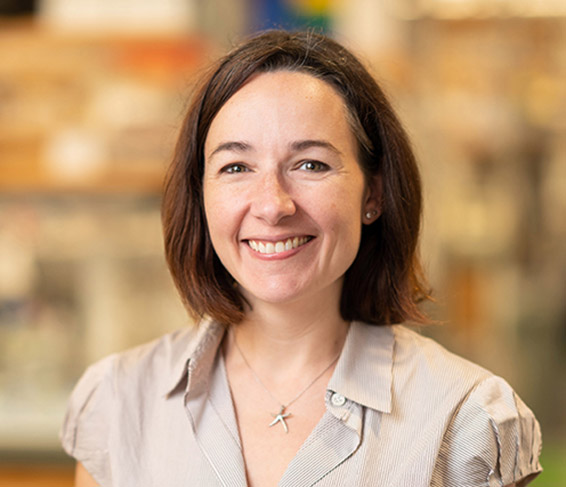
Stephanie K. Dougan, PhD
Contact Information
Office Phone Number
Biography
Stephanie K. Dougan, PhD
Stephanie Dougan received her PhD in immunology from Harvard University in 2007 after studying NKT cells and CD1d antigen presentation with Dr. Richard Blumberg. She then performed postdoctoral work at the Whitehead Institute with Dr. Hidde Ploegh. While at Whitehead, she collaborated with Dr. Rudolf Jaenisch to learn somatic cell nuclear transfer and generate a panel of transnuclear mice. Stephanie Dougan joined the DFCI and Harvard faculty in 2014.
Researcher
Physician
Recent Awards
-
Pathway to Leadership Award, Pancreatic Cancer Action Network and the American Association of Cancer Research
2012-2017
Research
Preclinical models for immunotherapy, including transnuclear and CRISPR gene-modified mice
Somatic cell nuclear transfer (SCNT) may be used to clone mice from lymphocytes of defined specificity. By harvesting as few as 200 primary lymphocytes from animals that are at the peak of an immune response, and by transfer of the nucleus from such antigen specific lymphocytes into an enucleated oocyte, embryonic stem cells that harbor the genetic rearrangements encoding the original antigen receptor may be obtained and used for the construction of transnuclear mice.
These animals contain T or B cells of the appropriate specificity, have no genetic alterations other than the physiological TCR/BCR rearrangements, and are the closest approximation of physiological immune responses to date. Importantly, the generation of transnuclear mice is rapid, requiring approximately 6 weeks from T cell harvest to obtaining chimeric animals. Like TCR and BCR transgenics, transnuclear mice are broadly useful for addressing diverse questions. The Dougan lab generates transnuclear mouse models to explore questions of anti-tumor immunity.
Our long term goal is to understand the complex network of cellular interactions that shape the tumor microenvironment. CD8 T cells do not occur in isolation; they operate in oligoclonal fashion amid regulatory T cells, myeloid cells, and other immune infiltrates, not to mention heterogeneous tumor cells, stroma, and vasculature. These interactions cannot be accurately modeled using xenografts, nor are they fully replicated in humanized mice that develop human leukocytes, but still face cross-species barriers with respect to immune-stromal interactions and T cell development.
The Dougan lab clones mice from a variety of tumor-infiltrating lymphocytes in order to study the effects of each lymphocyte type in isolation, and more importantly, when combined with each other and with various immune-based therapies. We also use the technology in reverse to clone mice from tumor-infiltrating Tregs as a means of determining their antigen-specificity.
Currently the lab focuses on three major tumor types: melanoma, sarcoma, and pancreatic cancer. Of these, pancreatic cancer has been the most refractory to immunotherapy. We are using a combination of RNAseq profiling and targeted gene silencing in pancreatic-tumor specific CD8 T cells to design effective immunotherapies for pancreatic cancer.
Research Departments
Research Website
http://douganlab.dana-farber.org/Publications
-
Metabolic modulation of mitochondrial mass during CD4+ T cell activation. Cell Chem Biol. 2023 09 21; 30(9):1064-1075.e8. View in: Pubmed
-
PD-1 blockade induces reactivation of non-productive T cell responses characterized by NF-kB signaling in patients with pancreatic cancer. Clin Cancer Res. 2023 Sep 21. View in: Pubmed
-
Correction: PD-1 blockade and CDK4/6 inhibition augment nonoverlapping features of T cell activation in cancer. J Exp Med. 2023 Sep 04; 220(9). View in: Pubmed
-
IL-3 finds its home in the brain. Immunity. 2023 07 11; 56(7):1431-1433. View in: Pubmed
-
Blockade of innate inflammatory cytokines TNFa, IL-1ß, or IL-6 overcomes virotherapy-induced cancer equilibrium to promote tumor regression. Immunother Adv. 2023; 3(1):ltad011. View in: Pubmed
-
Pancreatic Neoplasms Are Frighteningly Common: A Role for Immune Surveillance? Cancer Discov. 2023 06 02; 13(6):1288-1290. View in: Pubmed
-
G-CSF rescue of FOLFIRINOX-induced neutropenia leads to systemic immune suppression in mice and humans. J Immunother Cancer. 2023 06; 11(6). View in: Pubmed
-
Transforming Growth Factor-ß Blockade in Pancreatic Cancer Enhances Sensitivity to Combination Chemotherapy. Gastroenterology. 2023 10; 165(4):874-890.e10. View in: Pubmed
-
Immune mechanisms of toxicity from checkpoint inhibitors. Trends Cancer. 2023 07; 9(7):543-553. View in: Pubmed
-
In vitro flow cytometry assay to assess primary human and mouse macrophage phagocytosis of live cells. STAR Protoc. 2023 Apr 18; 4(2):102240. View in: Pubmed
-
cIAP1/2 Antagonism Induces Antigen-Specific T Cell-Dependent Immunity. J Immunol. 2023 04 01; 210(7):991-1003. View in: Pubmed
-
Ornithine aminotransferase supports polyamine synthesis in pancreatic cancer. Nature. 2023 04; 616(7956):339-347. View in: Pubmed
-
IFN? is a central node of cancer immune equilibrium. Cell Rep. 2023 03 28; 42(3):112219. View in: Pubmed
-
PD-1 blockade and CDK4/6 inhibition augment nonoverlapping features of T cell activation in cancer. J Exp Med. 2023 Apr 03; 220(4). View in: Pubmed
-
Bicarbonate transport as a vulnerability in pancreatic cancer. Nat Cancer. 2022 Dec 15. View in: Pubmed
-
Neoadjuvant Chemotherapy Is Associated with Altered Immune Cell Infiltration and an Anti-Tumorigenic Microenvironment in Resected Pancreatic Cancer. Clin Cancer Res. 2022 12 01; 28(23):5167-5179. View in: Pubmed
-
A split, conditionally active mimetic of IL-2 reduces the toxicity of systemic cytokine therapy. Nat Biotechnol. 2023 04; 41(4):532-540. View in: Pubmed
-
Human differentiated eosinophils release IL-13 in response to IL-33 stimulation. Front Immunol. 2022; 13:946643. View in: Pubmed
-
Antigen identification and high-throughput interaction mapping by reprogramming viral entry. Nat Methods. 2022 04; 19(4):449-460. View in: Pubmed
-
Translational advances in pancreatic ductal adenocarcinoma therapy. Nat Cancer. 2022 03; 3(3):272-286. View in: Pubmed
-
Dangerous dynamic duo: Lactic acid and PD-1 blockade. Cancer Cell. 2022 02 14; 40(2):127-130. View in: Pubmed
-
Radiation combines with immune checkpoint blockade to enhance T cell priming in a murine model of poorly immunogenic pancreatic cancer. Open Biol. 2021 11; 11(11):210245. View in: Pubmed
-
Tissue eosinophils express the IL-33 receptor ST2 and type 2 cytokines in patients with eosinophilic esophagitis. Allergy. 2022 02; 77(2):656-660. View in: Pubmed
-
Eosinophils in Health and Disease: A State-of-the-Art Review. Mayo Clin Proc. 2021 10; 96(10):2694-2707. View in: Pubmed
-
Opportunities for Utilization of DNA Repair Inhibitors in Homologous Recombination Repair-Deficient and Proficient Pancreatic Adenocarcinoma. Clin Cancer Res. 2021 12 15; 27(24):6622-6637. View in: Pubmed
-
Type 2 immunity is maintained during cancer-associated adipose tissue wasting. Immunother Adv. 2021 Jan; 1(1):ltab011. View in: Pubmed
-
cIAP1/2 antagonism eliminates MHC class I-negative tumors through T cell-dependent reprogramming of mononuclear phagocytes. Sci Transl Med. 2021 05 19; 13(594). View in: Pubmed
-
Inhibition of CDK4/6 Promotes CD8 T-cell Memory Formation. Cancer Discov. 2021 10; 11(10):2564-2581. View in: Pubmed
-
EZH2 inhibition activates a dsRNA-STING-interferon stress axis that potentiates response to PD-1 checkpoint blockade in prostate cancer. Nat Cancer. 2021 04; 2(4):444-456. View in: Pubmed
-
Understanding and treating the inflammatory adverse events of cancer immunotherapy. Cell. 2021 03 18; 184(6):1575-1588. View in: Pubmed
-
TGFß: Protecting PD-1 from mRNA Decay. Cancer Immunol Res. 2020 12; 8(12):1464. View in: Pubmed
-
Molecular Pathways of Colon Inflammation Induced by Cancer Immunotherapy. Cell. 2020 08 06; 182(3):655-671.e22. View in: Pubmed
-
Neoleukin-2 enhances anti-tumour immunity downstream of peptide vaccination targeted by an anti-MHC class II VHH. Open Biol. 2020 02; 10(2):190235. View in: Pubmed
-
SMAC mimetics throw a molecular switch to control TH17 responses. Sci Signal. 2019 08 27; 12(596). View in: Pubmed
-
Programmable bacteria as cancer therapy. Nat Med. 2019 07; 25(7):1030-1031. View in: Pubmed
-
Transnuclear mice reveal Peyer's patch iNKT cells that regulate B-cell class switching to IgG1. EMBO J. 2019 07 15; 38(14):e101260. View in: Pubmed
-
Transnuclear mice reveal Peyer's patch iNKT cells that regulate B-cell class switching to IgG1. EMBO J. 2019 May 31. View in: Pubmed
-
GM-CSF, IL-3, and IL-5 Family of Cytokines: Regulators of Inflammation. Immunity. 2019 04 16; 50(4):796-811. View in: Pubmed
-
Broadening the Impact of Immunotherapy to Pancreatic Cancer: Challenges and Opportunities. Gastroenterology. 2019 05; 156(7):2056-2072. View in: Pubmed
-
Cancer Immunotherapy: Beyond Checkpoint Blockade. Annu Rev Cancer Biol. 2019 Mar; 3:55-75. View in: Pubmed
-
Altered Binding of Tumor Antigenic Peptides to MHC Class I Affects CD8+ T Cell-Effector Responses. Cancer Immunol Res. 2018 12; 6(12):1524-1536. View in: Pubmed
-
Radiation and Local Anti-CD40 Generate an Effective in situ Vaccine in Preclinical Models of Pancreatic Cancer. Front Immunol. 2018; 9:2030. View in: Pubmed
-
Rapid CLIP dissociation from MHC II promotes an unusual antigen presentation pathway in autoimmunity. J Exp Med. 2018 10 01; 215(10):2617-2635. View in: Pubmed
-
One-step CRISPR/Cas9 method for the rapid generation of human antibody heavy chain knock-in mice. EMBO J. 2018 09 14; 37(18). View in: Pubmed
-
Unmasking Pancreatic Cancer: Epitope Spreading After Single Antigen Chimeric Antigen Receptor T-Cell Therapy in a Human Phase I Trial. Gastroenterology. 2018 07; 155(1):11-14. View in: Pubmed
-
Regulation of innate and adaptive antitumor immunity by IAP antagonists. Immunotherapy. 2018 07; 10(9):787-796. View in: Pubmed
-
The systemic response to surgery triggers the outgrowth of distant immune-controlled tumors in mouse models of dormancy. Sci Transl Med. 2018 04 11; 10(436). View in: Pubmed
-
Anti-CTLA-4 therapy requires an Fc domain for efficacy. Proc Natl Acad Sci U S A. 2018 04 10; 115(15):3912-3917. View in: Pubmed
-
Targeting Cytokine Therapy to the Pancreatic Tumor Microenvironment Using PD-L1-Specific VHHs. Cancer Immunol Res. 2018 04; 6(4):389-401. View in: Pubmed
-
Generation of Ca2+-independent sortase A mutants with enhanced activity for protein and cell surface labeling. PLoS One. 2017; 12(12):e0189068. View in: Pubmed
-
IAP Antagonists Enhance Cytokine Production from Mouse and Human iNKT Cells. Cancer Immunol Res. 2018 01; 6(1):25-35. View in: Pubmed
-
The Pancreatic Cancer Microenvironment. Cancer J. 2017 Nov/Dec; 23(6):321-325. View in: Pubmed
-
PD-L1 is an activation-independent marker of brown adipocytes. Nat Commun. 2017 09 21; 8(1):647. View in: Pubmed
-
CD1d-Restricted pathways in hepatocytes control local natural killer T cell homeostasis and hepatic inflammation. Proc Natl Acad Sci U S A. 2017 09 26; 114(39):10449-10454. View in: Pubmed
-
Localized CD47 blockade enhances immunotherapy for murine melanoma. Proc Natl Acad Sci U S A. 2017 09 19; 114(38):10184-10189. View in: Pubmed
-
Monoclonal Invariant NKT (iNKT) Cell Mice Reveal a Role for Both Tissue of Origin and the TCR in Development of iNKT Functional Subsets. J Immunol. 2017 07 01; 199(1):159-171. View in: Pubmed
-
Targeting Immunotherapy to the Tumor Microenvironment. J Cell Biochem. 2017 10; 118(10):3049-3054. View in: Pubmed
-
Engineered erythrocytes covalently linked to antigenic peptides can protect against autoimmune disease. Proc Natl Acad Sci U S A. 2017 03 21; 114(12):3157-3162. View in: Pubmed
-
Clinical Dosing Regimen of Selinexor Maintains Normal Immune Homeostasis and T-cell Effector Function in Mice: Implications for Combination with Immunotherapy. Mol Cancer Ther. 2017 03; 16(3):428-439. View in: Pubmed
-
Cocapture of cognate and bystander antigens can activate autoreactive B cells. Proc Natl Acad Sci U S A. 2017 01 24; 114(4):734-739. View in: Pubmed
-
Tissue-specific emergence of regulatory and intraepithelial T cells from a clonal T cell precursor. Sci Immunol. 2016 Aug 26; 1(2):eaaf7471. View in: Pubmed
-
Transnuclear CD8 T cells specific for the immunodominant epitope Gra6 lower acute-phase Toxoplasma gondii burden. Immunology. 2016 Nov; 149(3):270-279. View in: Pubmed
-
Longitudinal multiparameter assay of lymphocyte interactions from onset by microfluidic cell pairing and culture. Proc Natl Acad Sci U S A. 2016 06 28; 113(26):E3599-608. View in: Pubmed
-
Corrigendum: CEACAM1 regulates TIM-3-mediated tolerance and exhaustion. Nature. 2016 08 18; 536(7616):359. View in: Pubmed
-
Corrigendum: Increasing the efficiency of precise genome editing with CRISPR-Cas9 by inhibition of nonhomologous end joining. Nat Biotechnol. 2016 Feb; 34(2):210. View in: Pubmed
-
Disruption of Sphingolipid Biosynthesis Blocks Phagocytosis of Candida albicans. PLoS Pathog. 2015 Oct; 11(10):e1005188. View in: Pubmed
-
Increasing the efficiency of precise genome editing with CRISPR-Cas9 by inhibition of nonhomologous end joining. Nat Biotechnol. 2015 May; 33(5):538-42. View in: Pubmed
-
Profiling lymphocyte interactions at the single-cell level by microfluidic cell pairing. Nat Commun. 2015 Jan 13; 6:5940. View in: Pubmed
-
A new TLR2 agonist promotes cross-presentation by mouse and human antigen presenting cells. Hum Vaccin Immunother. 2015; 11(8):2038-50. View in: Pubmed
-
Intestinal colonization by Candida albicans alters inflammatory responses in Bruton's tyrosine kinase-deficient mice. PLoS One. 2014; 9(11):e112472. View in: Pubmed
-
Early-onset Crohn's disease and autoimmunity associated with a variant in CTLA-4. Gut. 2015 Dec; 64(12):1889-97. View in: Pubmed
-
CEACAM1 regulates TIM-3-mediated tolerance and exhaustion. Nature. 2015 01 15; 517(7534):386-90. View in: Pubmed
-
Engineered red blood cells as carriers for systemic delivery of a wide array of functional probes. Proc Natl Acad Sci U S A. 2014 Jul 15; 111(28):10131-6. View in: Pubmed
-
In vivo discovery of immunotherapy targets in the tumour microenvironment. Nature. 2014 Feb 06; 506(7486):52-7. View in: Pubmed
-
Antigen-specific B-cell receptor sensitizes B cells to infection by influenza virus. Nature. 2013 Nov 21; 503(7476):406-9. View in: Pubmed
-
Transnuclear TRP1-specific CD8 T cells with high or low affinity TCRs show equivalent antitumor activity. Cancer Immunol Res. 2013 Aug; 1(2):99-111. View in: Pubmed
-
Stochastic cytokine expression induces mixed T helper cell States. PLoS Biol. 2013 Jul; 11(7):e1001618. View in: Pubmed
-
Bruton's Tyrosine Kinase (BTK) and Vav1 contribute to Dectin1-dependent phagocytosis of Candida albicans in macrophages. PLoS Pathog. 2013; 9(6):e1003446. View in: Pubmed
-
IgG1+ ovalbumin-specific B-cell transnuclear mice show class switch recombination in rare allelically included B cells. Proc Natl Acad Sci U S A. 2012 Aug 21; 109(34):13739-44. View in: Pubmed
-
Preparation of unnatural N-to-N and C-to-C protein fusions. Proc Natl Acad Sci U S A. 2012 Jul 24; 109(30):11993-8. View in: Pubmed
-
M13 bacteriophage display framework that allows sortase-mediated modification of surface-accessible phage proteins. Bioconjug Chem. 2012 Jul 18; 23(7):1478-87. View in: Pubmed
-
Sortase-catalyzed transformations that improve the properties of cytokines. Proc Natl Acad Sci U S A. 2011 Feb 22; 108(8):3169-74. View in: Pubmed
-
Derlin-2-deficient mice reveal an essential role for protein dislocation in chondrocytes. Mol Cell Biol. 2011 Mar; 31(6):1145-59. View in: Pubmed
-
IAP inhibitors enhance co-stimulation to promote tumor immunity. J Exp Med. 2010 Sep 27; 207(10):2195-206. View in: Pubmed
-
Primary deficiency of microsomal triglyceride transfer protein in human abetalipoproteinemia is associated with loss of CD1 function. J Clin Invest. 2010 Aug; 120(8):2889-99. View in: Pubmed
-
Subtilase cytotoxin cleaves newly synthesized BiP and blocks antibody secretion in B lymphocytes. J Exp Med. 2009 Oct 26; 206(11):2429-40. View in: Pubmed
-
XBP-1-deficient plasmablasts show normal protein folding but altered glycosylation and lipid synthesis. J Immunol. 2009 Sep 15; 183(6):3690-9. View in: Pubmed
-
XBP-1 regulates signal transduction, transcription factors and bone marrow colonization in B cells. EMBO J. 2009 Jun 03; 28(11):1624-36. View in: Pubmed
-
Microsomal triglyceride transfer protein regulates endogenous and exogenous antigen presentation by group 1 CD1 molecules. Eur J Immunol. 2008 Aug; 38(8):2351-9. View in: Pubmed
-
Microsomal triglyceride transfer protein in plasma and cellular lipid metabolism. Curr Opin Lipidol. 2008 Jun; 19(3):277-84. View in: Pubmed
-
Role of NKT cells in the digestive system. III. Role of NKT cells in intestinal immunity. Am J Physiol Gastrointest Liver Physiol. 2007 Dec; 293(6):G1101-5. View in: Pubmed
-
MTP regulated by an alternate promoter is essential for NKT cell development. J Exp Med. 2007 Mar 19; 204(3):533-45. View in: Pubmed
-
CD1 expression on antigen-presenting cells. Curr Top Microbiol Immunol. 2007; 314:113-41. View in: Pubmed
-
Microsomal triglyceride transfer protein lipidation and control of CD1d on antigen-presenting cells. J Exp Med. 2005 Aug 15; 202(4):529-39. View in: Pubmed
-
A rare cause of abdominal pain. Gut. 2004 Sep; 53(9):1261, 1266. View in: Pubmed
-
Drosophila wingless generates cell type diversity among engrailed expressing cells. Nature. 1992 Nov 26; 360(6402):347-50. View in: Pubmed
Locations

Dana-Farber Cancer Institute
450 Brookline Avenue Smith 770A Boston, MA 02215Dana-Farber Cancer Institute

